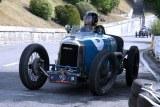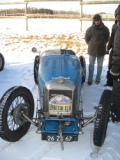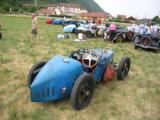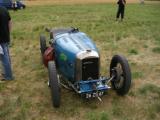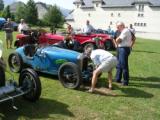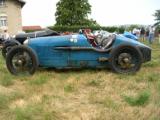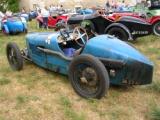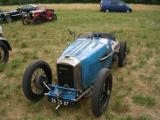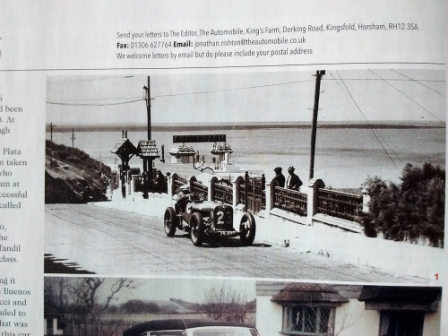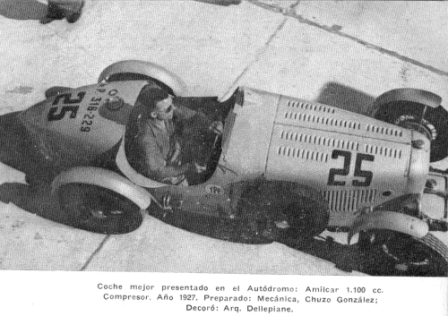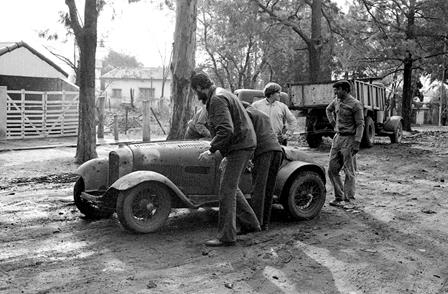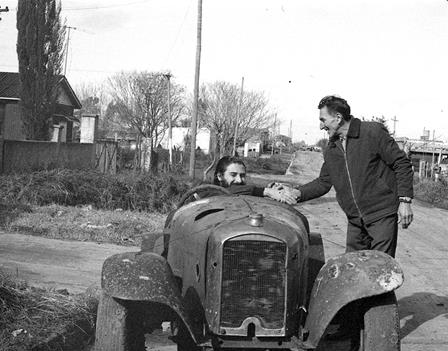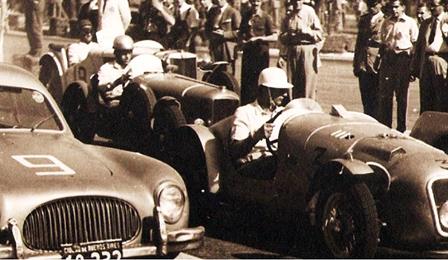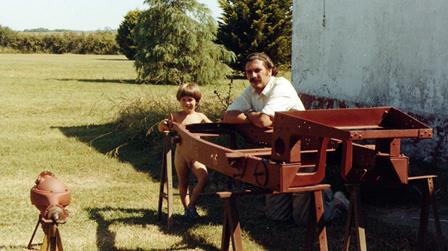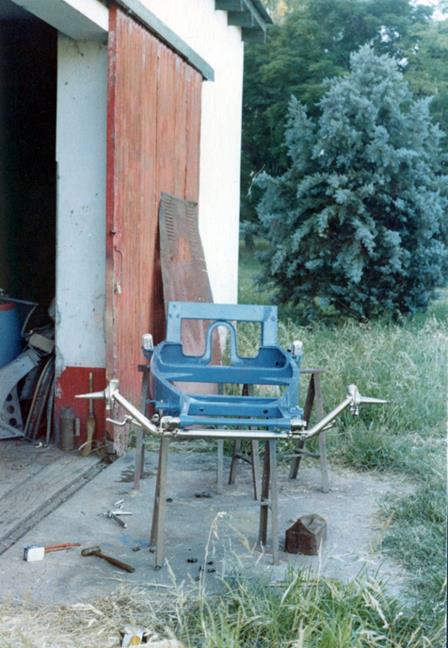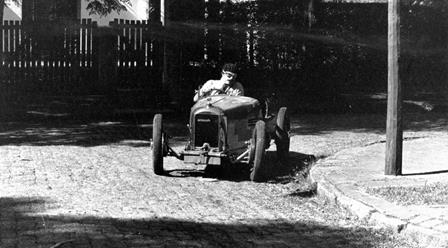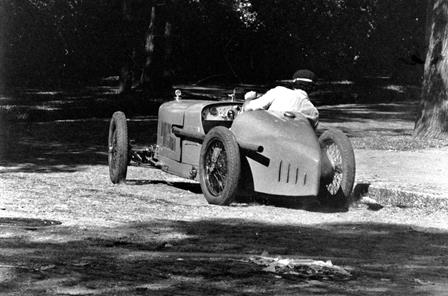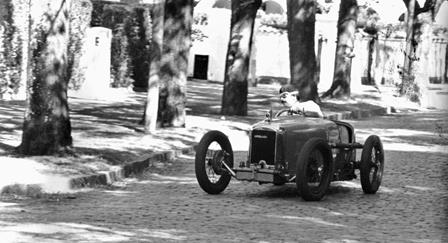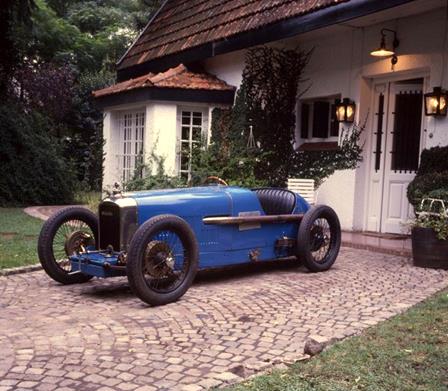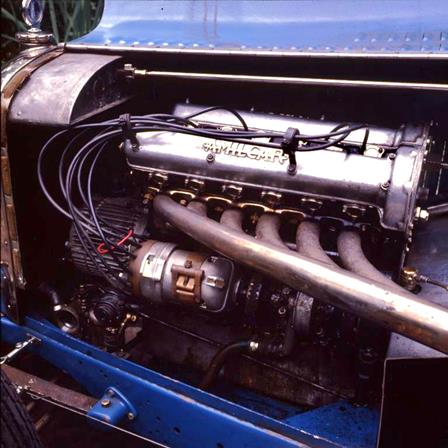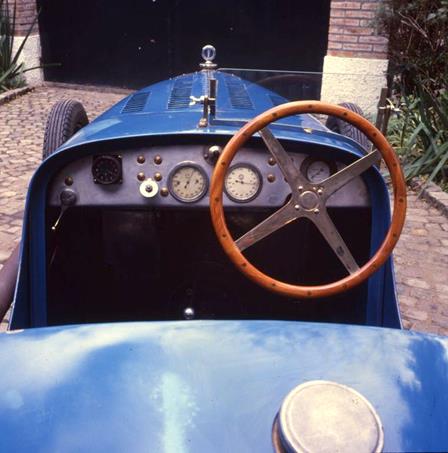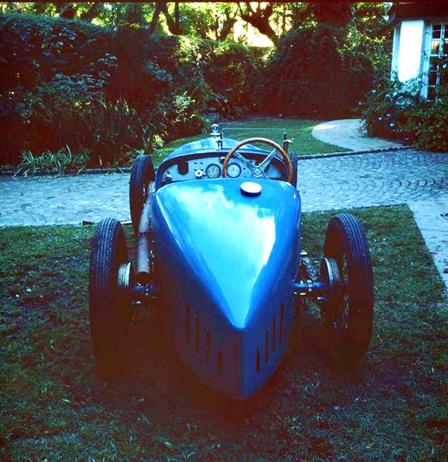


- Guy Clavel
- Argentine
All the cars in the picture were of Martin de Alzaga Unsue. The place Buenos Aires , the big racer is a Sumbeam.
To be written in Spanished: below written article
El C6 junto al Sumbeam 4,5 litros ganador del Grand Prix de Miramas
en la casa de Macoco en Paris
Con los recientes artículos sobre los Amilcar 6 cilindros de Simon
Moore para la revista The Automobile, y principalmente con su última
carta de lectores sobre el Amilcar C6 de “Macoco” compitiendo en la
ciudad de Mar del Plata, no pude evitar que viniera a mi memoria el
viejo misterio sobre estos modelos en Argentina (y alrededores…).
Mi padre, durante gran parte de su vida, se dedicó a la investigación y restauración de distintos ejemplares de esta marca francesa. También fue dueño de uno de estos Amilcar Grand Prix que llegaron a Argentina y que, aparentemente, fuera propiedad de Martín “Macoco” de Alzaga Unzué. Lamentablemente él murió hace muchos años y dejó muy poco escrito sobre la cuestión. Sólo en algunos artículos que publicó durante sus años de periodista en diversas revistas temáticas hizo comentarios sobre la historia de esta marca en el país, pero también nos dejó todas sus dudas, que siguen siendo las mismas que tengo hoy en día…
Él recordaba que siendo niño iba a una agencia de autos en la Av. Juan B. Justo y Av. Santa Fe, relativamente cerca de su casa, donde había un Amilcar 6 cilindros en venta. Fantaseaba que su padre se lo compraría algún día y asiduamente iba a ver a “su” auto. Hasta llegó a ganarse la confianza de los vendedores que le permitían sentarse adentro y tomar el volante para sentir el poder de la historia. Un día, como tantos otros, lo fue a ver y ya no estaba más. Este había sido el auto de “Chuzo” González, que algunos expertos en el tema afirman que fue exportado a Alemania a fines de los 50s o principios de los 60s.
Y aquí comienzan los misterios. Hace algunos años que estoy tratando de averiguar el enigma de los Amilcar 6 cilindros que parece que a muy pocos interesa, al menos en Argentina. Los datos que logré conseguir no son muchos pero el tema comienza más o menos así: según el libro Fuerza Libre, de Guillermo Sánchez, en 1925 hubo una representación de la casa Amilcar en Buenos Aires a cargo de un señor llamado Raúl Chiesa. Aparentemente, se importó un número considerable de estos autos y muchos corrieron en el viejo circuito de la localidad de San Martín. No se sabe bien si fueron sólo pequeños modelos de 4 cilindros -mi padre logró encontrar muchos de éstos-, o también algunos 6 cilindros. Según la mayoría de los “monos sabios” sólo participaron de los primeros, pero algunos de esos ejemplares tenían compresor.
A principios de los años 70 mi padre le hizo una entrevista a “Macoco” para la revista Corsa. A partir de ese momento logró entablar una amistad con el dandy y según sus recuerdos le comentó que en los años 20 se trajo dos 6 cilindros de Europa. La leyenda cuenta que un día pasó frente a la agencia Amilcar en los Champs Elysées de París y vio que había dos en exposición. Cuando preguntó el valor le respondieron una cifra muy elevada, equivalente a un Rolls-Royce del momento. La respuesta de “Macoco” fue: “Muy bien, me llevo los dos…”. Nunca nadie pudo comprobar la anécdota pero la realidad es que tuvo dos de estos Amilcar, que según Guillermo Sánchez eran un C6 y un C0. Según “Macoco”, uno era el que había ganado el Grand Prix de Voiturettes en 1925 y el otro era una “réplica” del anterior. Supongo que lo dijo por el C6 comparado con el C0 por las bancadas de metales y no de rulemanes. No sé bien a que se refirió con esto, pero con uno de los dos corrió algunas carreras en Europa, entre ellas la trepada de Behovia en los Bajos Pirineos donde salió segundo detrás de un Delage 12 cilindros.
Luego, cuando regresó a la Argentina, no se sabe bien si se trajo uno o los dos autos. Según lo que pude deducir trajo los dos. Según “Macoco” también, pero hay quienes creen que se pudo haber “confundido” y sólo trajo uno. En la foto que publicó Simon Moore en The Automobile, se lo ve corriendo en Mar del Plata con el auto que más usó y al que luego le adaptaron un motor Ford V8, primero un 60 y luego un 85 HP. Con el tiempo este auto fue desmaterializándose en diferentes categorías menores donde lo fueron sometiendo a diversas modificaciones. Se sabe también que al último V8 le agregaron un compresor Mc Culoch y que terminó sus días con un tren delantero completo de Lancia Augusta. El último registro de este auto es que fue de Enrique Moyano hasta que murió. Luego, como dijo mi viejo, “se lo tragó literalmente la tierra”.
El otro puede haber sido rescatado por mi padre siguiendo algunas indicaciones de lo que “Macoco” recordaba. Pero el dato certero recién llegó en 1968 a través de una persona que quiso publicarlo para la venta en los clasificados de la revista Corsa, aunque eso nunca llegó a suceder porque no pasó el “filtro” de la redacción en la que el trabajaba. El auto sin motor estaba en un desarmadero en Temperley, en las afueras de Buenos Aires, con algunas modificaciones del tiempo y mucha corrosión, pero nada grave. Hacerse del motor y sus partes fue lo más difícil. El resto estaba todo.
Mi padre fue recorriendo los diferentes talleres a los que el antiguo dueño recordaba que había encargado tareas y nunca pasó por ellas. Así fue pasando el tiempo, yendo de uno a otro, hasta que llegó a un rectificador donde por enésima vez preguntó por ese motor raro. “Ah, ¿uno viejo de aluminio?”, le preguntó el mecánico, “Sí, sí, ese” le respondió Sánchez Ortega. “¡Qué suerte tiene!, justo lo estábamos por tapar con cemento”, le dijo el mecánico mientras lo llevaba hasta el fondo del taller donde había un enorme pozo de un poste de luz. Lo estaban rellenando con basura y fierros para luego volcarle cemento líquido. En el oscuro fondo se podía ver un motor donde se leía Amilcar en las tapas de los árboles de levas.
Con la ayuda del mago “Pichón” Rocha lograron, con sangre, sudor y lágrimas verdes, hacerlo andar. Rodolfo Iriarte, testigo de toda esta historia, recuerda que había muchas piezas irrecuperables y que las bielas del motor eran unas de Ford forjadas que las habían soldado. La única solución que encontraron fue ponerle bielas de Mini Cooper y los pistones hechos a medida. Esta atrocidad de las bielas Ford fue autoría de Jorge Malbrán, confesó él mismo, cuando el auto era de “Chuzo” y corrió en las primeras carreras del Club de Automóviles Sport. Entonces ¿este auto es el de González y nunca fue exportado a Alemania como aseguraban? ¿O sólo quedó el motor y el resto del auto se fue?
En segunda fila Chuzo y su Amilcar en una largada del CAS en la costanera
Pero la historia es más complicada. Juan Jiménez Cabrera, un uruguayo de Montevideo, importo a su país un C6 en 1929. Aquí entra el tercer Amilcar de la discordia… Se sabe que corrió varias carreras, muchas de ellas sobre la Rambla Wilson de su ciudad. A mediados de los años 30 se lo vendió a Jorge Montero, que lo corrió algunos años más y también terminó adaptándole un Ford V8. Hay que comprender que esos motores eran muy complejos para los mecánicos locales y conseguir repuestos era muy difícil o casi imposible. La opción de “americanizar” la mecánica era muy tentadora y de esa manera se podía lograr un excelente híbrido con la potencia y confiabilidad de un motor americano y las prestaciones que brindaba un chasis Grand Prix europeo. Luego no se supo más nada sobre este auto. Algunas hipótesis sugieren que pudo haber sido exportado a Argentina pero la realidad es que no hay ningún registro sobre eso.
Enrique y Santiago con chasis Amilcar en Pergamino
Chasis en construccion en Pergamino 80s
La restauración del C6 de mi padre llevó años y muchos disgustos. Junto a la ayuda de su amigo Desmond Peacock desde Inglaterra y muchos otros en Buenos Aires lograron hacerlo rugir. Gran parte de la ayuda en este trabajo fue a cargo de Héctor “Chiquito” Solmi en el galpón del campo en Pergamino, principalmente todo el trabajo del chasis. Una vez restaurado completamente el auto quedó espectacular y sonaba que estremecía la piel (cuando arrancaba…), pero había un gran problema, mi padre medía 1,90 m y el auto bordeaba el límite de ser un juguete. De la única manera que podía entrar ahí era si le sacaba los asientos. Haciendo contorsiones con su prominente panza se introducía allí poco a poco. Pero salir era un drama. El auto lo corrió en algunas carreras del Club del Automóviles Sport sin demasiados logros ni satisfacciones. El resultado fue que unos pocos años después lo vendió y el C6 volvió a Francia luego de 60 años. Este fue el último modelo que hubo en el país.
Entonces las dudas son: ¿”Macoco” trajo dos C6 a Argentina? ¿Alguno de los dos era un C0? ¿El de “Chuzo” González cuál fue? ¿Era la “replica” de “Macoco” o fue el de Montevideo? ¿Habrá sido uno que trajo posteriormente “Macoco” y no recordaba? ¿Raúl Chiesa habrá traído algún otro “no declarado” para su agencia? ¿El auto de mi padre fue un chasis de C6 con el motor de otro? En definitiva, ¿cuántos Amilcar 6 cilindros hubo en estas costas?
Todo indicaría que el auto de mi padre sería el que fue de “Chuzo”, principalmente por algunas características de la carrocería. Entonces, ¿el que se exportó habrá sido el uruguayo? ¿Se exportó el segundo de “Macoco” y el de mi padre era el uruguayo? ¿O no se exportó ninguno en los años sesenta? ¡Me vuelvo loco!
Mi padre también tuvo un CGSs que usó durante muchos años y proyectos varios con otros 4 cilindros. La mayoría de ellos volvieron a Europa y estoy seguro que allá deben tener un seguimiento histórico más preciso de sus historias. Tal vez nuestros amigos del Amilcar Register me puedan ayudar con este misterio de los Amilcar 6 cilindros que pisaron Argentina y de una buena vez pueda dormir en paz.
Fotos: Archivo Sánchez Ortega
Publicado originalmente en la edición número 61 (Primavera 2015) de la Revista Rueda Rudge, órgano gráfico del Club de Automóviles Clásicos de la República Argentina.
Santiago E. Sánchez Ortega
My father, for much of his life, was dedicated to the research and restoration of various copies of this French brand. Also was the owner of one of these Grand Prix Amilcar, who arrived in Argentina, and, apparently, "Macoco" Martin de Alzaga Unzué property. Unfortunately he died many years ago and left very little written about the issue. Only in some articles published during his years of journalist in several magazines themes made comments about the history of this brand in the country, but also let us all your doubts, which remain the same as I have today...
He remembered that as a child he would a car agency in the Av. Juan B. Justo and Av. Santa Fe, relatively close to home, where a 6 Amílcar had cylinders for sale. I fantasized that his father someday would buy it is and regularly went to see "your" self. Until he came to win the confidence of vendors that allowed him to sit in and take the wheel to feel the power of the story. One day, like so many others, it was to see and was no more. This had been the car of "chuzo" Gonzalez, who some experts claim that it was exported to Germany in late 50s or early 60s.
And here begins the mysteries. A few years ago that I'm trying to figure out the riddle of the Amilcar 6 cylinders which seems that very few are interested in, at least in Argentina. Data that I managed to get are not many but the theme begins more or less like this: according to the book, force-free, Guillermo Sánchez, in 1925 there was a representation of the Amilcar in Buenos Aires House run by a man called Raúl Chiesa. Apparently, a considerable number of these cars were imported, and many ran on the old circuit in the town of San Martin. Well it is not known if they were only small 4-cylinder models - my father managed to find many of these-, or also some 6-cylinder. According to the majority of the wise"monkeys" only participated in the first, but some of those specimens had compressor.
Early 1970s my father made him an interview with "Macoco" for Corsa magazine. From that moment he managed to befriend the dandy and according to his memories told him that in the 1920s brought two 6-cylinder of Europe. Legend has it that one day passed by the Amilcar Agency on the Champs Elysées in Paris and saw that there were two on exhibition. When he asked the value they answered him a figure very high, equivalent to a Rolls-Royce of the moment. "Macoco" response was: "Okay, I get the two...". Ever failed to verify the story, but the reality is that it had two of these Amilcar, which according to Guillermo Sánchez were a C6 and a C0. According to "Macoco", one was who had won the Grand Prix for Voiturettes in 1925 and the other was a "replica" of the former. I guess that he said on the C6 compared with the C0 by the banks of metal and not of bearings. I do not know well to be concerned with this, but one of the two ran some races in Europe, including the climb of Behovia in the Pyrenees where he came second behind a Delage 12 cylinders.
Then, when he returned to Argentina, it is not known well if you brought one or two cars. According to what I could deduce brought the two. According to "Macoco" too, but there are those who believe that it could have "confused" and only brought one. In the photo who published Simon Moore in The Automobile, sees it running in Mar del Plata with the car that most used and that then broke you a motor Ford V8, first a 60 and then a 85 HP. Over time this car was dematerializing in lower categories were where by subjecting it to various modifications. Also known that the last V8 they added a Mc Culoch compressor and ended his days with a full landing gear Lancia Augusta. The last record of this car is that it was Enrique Moyano's until he died. Then, as said my dad, "the Earth swallowed him literally".
The other may have been rescued by my father following some indications of what "Macoco" remembered. But the accurate data newly arrived in 1968 through a person who wanted to post it for sale in the Classifieds of the Corsa magazine, although that never happen because it didn't "filter" of the writing in which the working. The car without engine was in a desarmadero in Temperley, on the outskirts of Buenos Aires, with some modifications of the time and many corrosion, but nothing serious. It was the most difficult to make of engine and its parts. The rest was all.
My father was touring the various workshops that former owner recalled that it had commissioned tasks and never passed through them. Thus he was spending the time, going from one to another, until he came to a rectifier where for the umpteenth time, asked for that rare engine. "Ah, one old aluminum?", asked the mechanic, "Yes, Yes, that" replied Sanchez Ortega. "What luck has!, we were just so by plugging with cement," said mechanic while carrying it to the bottom of the workshop where there was a huge well of a lamppost. They were filling it with trash and irons to then dump you liquid cement. In the dark background you could see an engine where you could read Amilcar camshafts covers.
With the help of the magician "pichon" Rocha managed, with blood, sweat and tears green, make it walk. Rodolfo Iriarte, witness to all this history, recalled that there were many irreplaceable parts and engine connecting rods were some Ford forged that had welded them. The only solution found was to put a Mini Cooper chainwheel and custom Pistons. This atrocity of rods Ford was authored by Jorge Malbrán, confessed himself when the car was "Dibbling" and ran in the first races of the automobile Sport Club. Then this car is that of Gonzalez and it was never exported to Germany as they claimed? Or left with only the engine and the rest of the car was?
But the story is more complicated. Juan Jiménez Cabrera, a Uruguayan Montevideo, import to your country a C6 in 1929. Here comes the third Amilcar of discord... It is known that he ran several races, many of them on the Rambla Wilson of his city. In the middle of the 1930s sold it to Jorge Montero, who ran it for a few years more and also retooled him a Ford V8. You have to understand that these engines were very complex for local mechanics and getting spare parts was very difficult or almost impossible. The option to "Americanize" the mechanics was very tempting and thus could be an excellent hybrid with the power and reliability of an American engine and the benefits provided by a chassis European Grand Prix. Then it is not learned more anything about this car. Some hypotheses suggest that it might have been exported to Argentina, but the reality is that no record there is about that.
The restoration of the C6's my father took years and many dislikes. With the help of his friend Desmond Peacock from England and many others in Buenos Aires they managed to make it ROAR. Much of the help in this work was in charge of Héctor "chiquito" Solmi in the barn of the field parchment, mainly all chassis work. Once fully restored the car was spectacular and sounded it quaked the skin (when pulled...), but had a big problem, my father measuring 1.90 m and the car along the boundary to be a toy. The only way that could enter there was if I took out the seats. Doing contortions with his prominent belly was it introduced there little by little. But leaving was a drama. The car ran it in some races of the Sport Automobile Club without too many achievements and satisfactions. The result was a few years later sold it to the C6 returned to France after 60 years. This was the last model that took place in the country.
Then the questions are: do "Macoco" brought Argentina two C6? Was one of the two a C0? It "chuzo" Gonzalez what was? It was "replica" of "Macoco" or was in Montevideo? Was it one that subsequently brought "Macoco" and did not remember? Will have Raúl Chiesa brought some other 'declared no' for your agency? Was the car of my father a C6 chassis with another engine? In short, Amilcar 6 How many cylinders there was on these shores?
Originally published in issue number 61 (spring 2015) of the magazine wheel Rudge, graphic organ of the classic cars of the Argentina Republic Club.
===========================================


